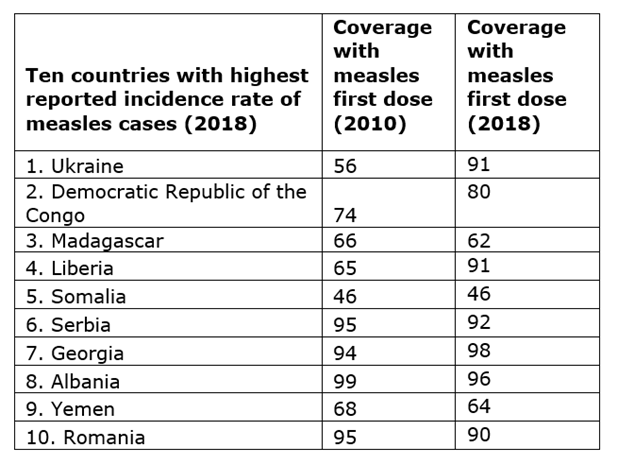Vietnam had 390,000 children missing out on lifesaving vaccines against measles, diphtheria and tetanus in 2018, according to new data from WHO and UNICEF.
Ten countries account for 60 percent of 20 million unprotected children worldwide, including Indonesia (one million), the Philippines (750,000) and Vietnam (390,000), the two organizations said in a press release on Monday.
Vaccination coverage with three doses of diphtheria, tetanus and pertussis (DTP3) and one shot of the measles vaccine has stalled at around 86 percent globally since 2010.
The WHO and UNICEF said this is high but not sufficient, as 95 percent coverage is needed – globally, across countries, and communities – to protect against outbreaks of vaccine-preventable diseases.
“Vaccines are one of our most important tools for preventing outbreaks and keeping the world safe,” said Dr. Tedros Adhanom Ghebreyesus, Director-General of the World Health Organization, was quoted as saying in the press release.
“While most children today are being vaccinated, far too many are left behind.
“Unacceptably, it’s often those who are most at risk – the poorest, the most marginalized, those touched by conflict or forced from their homes – are persistently missed.”
Most unvaccinated children live in the poorest countries, and are disproportionately in fragile or conflict-affected states.
If these children do get sick, they are at risk of the severest health consequences, and least likely to access lifesaving treatment and care.
Measles outbreaks reveal entrenched gaps
Stark disparities in vaccine access persist across and within countries of all income levels.
This has resulted in devastating measles outbreaks in many parts of the world – including countries that have high overall vaccination rates.
In 2018, almost 350,000 measles cases were reported around the world, more than doubling from 2017.
“Measles is a real-time indicator of where we have more work to do to fight preventable diseases,” said Henrietta Fore, UNICEF’s Executive Director.
“Because measles is so contagious, an outbreak points to communities that are missing out on vaccines due to access, costs or, in some places, complacency.
“We have to exhaust every effort to immunize every child.”
|
|
Ukraine leads a varied list of countries with the highest reported incidence rate of measles in 2018.
While the country has now managed to vaccinate over 90 percent of its infants, coverage had been low for several years, leaving a large number of older children and adults at risk.
Several other countries with a high incidence and high coverage have significant groups of people who have missed the measles vaccine in the past.
This shows how low coverage over time or discrete communities of unvaccinated people can spark deadly outbreaks.
Human papillomavirus vaccine coverage data
For the first time, there is also data on the coverage of human papillomavirus (HPV) vaccines, which protect girls against cervical cancer later in their life.
As of 2018, 90 countries – home to one in three girls worldwide - had introduced the HPV vaccine into their national programs.
Just 13 of these are lower-income countries.
This leaves those most at risk of the devastating impacts of cervical cancer still least likely to have access to the vaccine.
Together with partners like Gavi, the Vaccine Alliance, the WHO and UNICEF are supporting countries to strengthen their immunization systems and outbreak response, including by vaccinating all children with routine immunization, conducting emergency campaigns, and training health workers as an essential part of quality primary healthcare.
Since 2000, the WHO and UNICEF has jointly produced national immunization coverage estimates for member states on an annual basis.
In addition to producing the immunization coverage estimates for 2018, the WHO and UNICEF estimation process revises the entire historical series of immunization data with the latest available information.
The 2018 revision covers 39 years of coverage estimates, from 1980 to 2018.
DTP3 coverage is used as an indicator to assess the proportion of children vaccinated and is calculated for children under one year of age.
The estimated number of vaccinated children is calculated using population data provided by the 2019 World Population Prospects (WPP) from the United Nations.
Like us on Facebook or follow us on Twitter to get the latest news about Vietnam!



Max: 1500 characters
There are no comments yet. Be the first to comment.